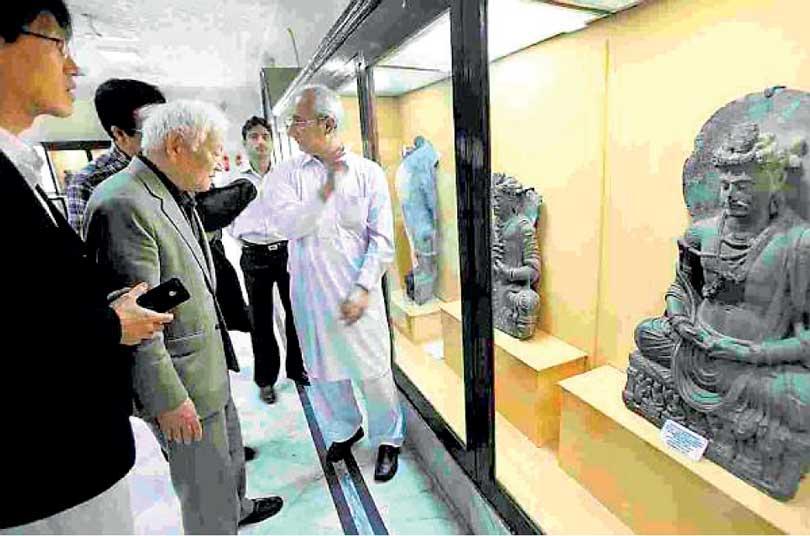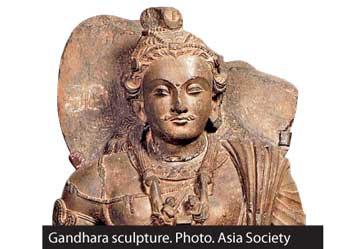Reply To:
Name - Reply Comment

Gandharan scuptures preserved in a Pakistani museum . Photo. Dawn
 The remnants of the Gandhara Buddhist civilization in Pakistan are a sight to behold, not just for Buddhist pilgrims but also for art lovers. Imposing stupas with intricate and lifelike carvings depicting various events in the Buddha’s life and his past births abound in the Swat Valley in North West Pakistan bordering Afghanistan.
The remnants of the Gandhara Buddhist civilization in Pakistan are a sight to behold, not just for Buddhist pilgrims but also for art lovers. Imposing stupas with intricate and lifelike carvings depicting various events in the Buddha’s life and his past births abound in the Swat Valley in North West Pakistan bordering Afghanistan.
It is amazing that an avowedly Islamic country, where idols are considered haram (forbidden), has diligently preserved these masterpieces, and that, against heavy odds. Mercifully, the icons escaped the Islamization drive of President Zia ul Haq (1978-1988).
 In 2006-2007, when the Taliban banned the preservation of these objects because even the existence of idols in the midst of Muslims was ‘haram’, President Pervez Musharraf negotiated the withdrawal of the Taliban from its destructive project. In 2016, when Pakistani archeologists discovered an ancient site at Bhamala in Swat in which there was a 48 ft long, 3rd Century AD, “Sleeping Buddha” statue, Imran Khan, who was then a Khyber Pakhtunkhwa leader (and President of the Pakistan Tehreek-i-Insaaf party) said: “ It is a world heritage site and because of that, people will come for religious tourism. The majority of the Pakistani population wants such sites restored.”
In 2006-2007, when the Taliban banned the preservation of these objects because even the existence of idols in the midst of Muslims was ‘haram’, President Pervez Musharraf negotiated the withdrawal of the Taliban from its destructive project. In 2016, when Pakistani archeologists discovered an ancient site at Bhamala in Swat in which there was a 48 ft long, 3rd Century AD, “Sleeping Buddha” statue, Imran Khan, who was then a Khyber Pakhtunkhwa leader (and President of the Pakistan Tehreek-i-Insaaf party) said: “ It is a world heritage site and because of that, people will come for religious tourism. The majority of the Pakistani population wants such sites restored.”
Apart from the government, individual Pakistanis have also helped preserve and protect Buddhist sites against the depredations of the Taliban, idol thieves and smugglers. There is the case of Osman Ulasyar who had stopped local boys from playing cricket in a field full of First Centry AD Buddhist stupas (burial sites containing relics). Then, at his own cost, he built a 300 ft. wall to protect the stupas.
Documentary on Gandhara
The Pakistan High Commission in Sri Lanka and the Sri Lankan Ministry of Buddha Sasana recently produced a documentary on the Gandhara civilization. The documentary, which is of Hollywood quality in both grandeur and technical finesse, was made by a joint team of Pakistanis and Sri Lankans and was launched by the Lankan Prime Minister Mahinda Rajapaksa. The Sri Lankan partner in the production was Kaushalya Wickramasinghe of Siddhivinayak Cine Arts (Private) Limited, an India-trained film maker. The Director was Mateen Saherai of Pakistan and the Production Controller Sajjad Mohommad was a Pakistani from the UK. Ven. Agrahera Kassapa Thero was the Senior content Adviser, and the concept and script were prepared by the Project Consultant Director, Vidyajothi Prof. Nimal Silva. Noted Sri Lankan film maker Chandran Rutnam was an advisor and some leading Lankan companies were among the sponsors.
Significantly, there was no reservation among the Pakistani collaborators about displaying the Hinduistic logo of the Siddhivinayak Cine Arts which was a picture of Lord Ganesha (or Gana Deviyo in Sinhala). The commentary did not black out the belief that Hindu Gods, Indra and Brahma, had stood by the Buddha right through from his birth to his death.
 The documentary took viewers on a seamless journey through various Gandhara heritage sites. Key events in the life of the Buddha were narrated effectively with the sculptures providing appropriate visuals. Panoramic views of the stupas in the picturesque Swat Valley were breathtaking.
The documentary took viewers on a seamless journey through various Gandhara heritage sites. Key events in the life of the Buddha were narrated effectively with the sculptures providing appropriate visuals. Panoramic views of the stupas in the picturesque Swat Valley were breathtaking.
In the Gandhara stupas, the Jataka (birth) stories of the Buddha and his previous incarnations are depicted in “imaginative detail and with a warmth of feeling,” comments Dr. Ihsan H. Nadiem author of Buddhist Gandhara. Some of the stories depicted in the sculptures are: Dipankara Jataka; Visvantara Jataka; Dream of Queen Mahamaya; Interpretation of the Dream; Birth of Siddhartha; Seven Steps of the Child; Horoscope; Marriage of Siddhartha and Yasodhara; Life in the Palace; First Meditation of Siddhartha; Renunciation; Great Departure; Farewell to Chandaka and Kanthaka; First Meeting with the Brahmans; Fasting for Salvation; Temptation and attack by Mara’s Host; Great Enlightenment; First Sermon; Miracle of Sravasti; Death of the Buddha; Cremation; and Distribution of the Relics of the Buddha. Gandhara art recreated life in detail.
Items of everyday use such as beds and vases etc. can be clearly seen in them. Gandhara art provides an insight into all aspect of life of the region at that time.
Time Line
Gandhara finds mention in 5th Century BC Greek accounts as it had by then become a melting pot of Persian and Hindu Vedic traditions. In 327-326 BC it was conquered by Alexander the Great who introduced Greek art. In 321 BC, the region came under the sway of Chandragupta Maurya of Magadha in Bihar. His grandson, the Buddhist Emperor Asoka, brought Buddhism to Gandhara. However, the Buddhist Gandhara civilization reached its pinnacle under the Kushan ruler Kanishka, who assumed power between 78 AD and 144 AD. A convert to Buddhism, Kanishka built innumerable stupas containing relics of the Buddha and Buddhist savants. “Fascinating works of architecture and art were produced in Gandhara under Kanishka,” Nadiem points out.
“By the second century BC, Taxila (Thakshashila) had become a multi-ethnic, multi-racial and multi-religious society, where Greeks, Indians, Bactrian and Western Iranians lived together. Remains of a Zoroastrian Temple from that period still exist at Jandial, directly north of Taxila,” says Brig.(R) Agha Ahmad Gul, former Vice Chancellor of Balochistan University. In contrast to present day religious groups which go for each other’s throats, the people of Gandhara lived in harmony despite ethnic and religious variations,” Brig.Gul noted.
The Gandhara civilization should be a model for today’s countries where intolerance is growing, Dr. Abdul Samad, Director of Archaeology and Museums in Khyber Pakhtunwala told Reuters. “Gandhara was the centre of religious harmony. It is here that one finds Greek, Roman, Persian, Hindu and Buddhist gods in a single panel,” he pointed out.
However, in 460 AD, a White Hun invasion crippled the civilization. Subsequently, waves of iconoclastic Islamic raiders from the West and North West pillaged and set up a new order. Still, vary many valuables survived.
Grecian Influence
On Gandhara art, Nadiem says that in the light of the contacts of the Kushan rulers with the West, there was a development of a style quite distinct from the mainstream Indian tradition and in certain respects inclined to the Western form, though the subject matter throughout remained local and Buddhist.
“The Kushans patronized foreign artists probably because of their being themselves alien to the land. They thus could not be taken to the fold of Hinduism. Their status led them to embrace Buddhism and favour foreign culture,” Nadiem adds.
According to Brig. Agha Ahmad Gul: “ Alexander’s stay in Gandhara was short (327 BC), but he left a sizeable population of Greeks in every region he conquered, including Gandhara. The craftsmen, soldiers and other followers were encouraged to inter-marry and blend with the locals, introducing the Greek civilization in conquered regions which affected their history for centuries to come.”
Image of the Buddha
One of the greatest contributions of Gandhara Buddhist art is the representation of the Buddha as we conceptualize him now, showing Greco-Roman influence. Nadiem says that the Buddha was first represented in the human form (and not just symbolically) in the Second and Third centuries AD which followed the emergence of devotional Buddhism at the time of Kanishka’s ‘Great Buddhist Council’. And it is also in Gandhara that there is the world’s only statue of a Fasting Buddha.
Pakistan is assiduously using its Buddhist heritage to forge cultural links with Buddhist countries and also promote religious tourism. Buddhist relics were brought to Sri Lanka for exhibition and trips had been arranged for Buddhist monks to visit Gandhara. And now a documentary on Gandhara has been made.
Currently, the Buddha’s images and relics are safe in Pakistan, and the museums there are well-maintained. But Islamic iconoclastic groups inspired by the Afghan Taliban or the ISIS do exist, and could strike any moment. The bid to project Pakistan as a multi-cultural tolerant country may receive a serious setback if the Islamic zealots are not reined in.